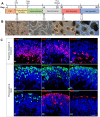Bioengineering Human Pluripotent Stem Cell-Derived Retinal Organoids and Optic Vesicle-Containing Brain Organoids for Ocular Diseases
- PMID: 36359825
- PMCID: PMC9653705
- DOI: 10.3390/cells11213429
Bioengineering Human Pluripotent Stem Cell-Derived Retinal Organoids and Optic Vesicle-Containing Brain Organoids for Ocular Diseases
Abstract
Retinal organoids are three-dimensional (3D) structures derived from human pluripotent stem cells (hPSCs) that mimic the retina's spatial and temporal differentiation, making them useful as in vitro retinal development models. Retinal organoids can be assembled with brain organoids, the 3D self-assembled aggregates derived from hPSCs containing different cell types and cytoarchitectures that resemble the human embryonic brain. Recent studies have shown the development of optic cups in brain organoids. The cellular components of a developing optic vesicle-containing organoids include primitive corneal epithelial and lens-like cells, retinal pigment epithelia, retinal progenitor cells, axon-like projections, and electrically active neuronal networks. The importance of retinal organoids in ocular diseases such as age-related macular degeneration, Stargardt disease, retinitis pigmentosa, and diabetic retinopathy are described in this review. This review highlights current developments in retinal organoid techniques, and their applications in ocular conditions such as disease modeling, gene therapy, drug screening and development. In addition, recent advancements in utilizing extracellular vesicles secreted by retinal organoids for ocular disease treatments are summarized.
Keywords: assembled organoids; extracellular vesicles; human induced pluripotent stem cells; ocular diseases; retinal organoids.
Conflict of interest statement
The authors declare no conflict of interest.
Figures





References
Publication types
MeSH terms
Grants and funding
LinkOut - more resources
Full Text Sources

